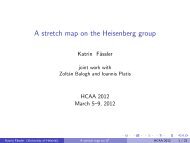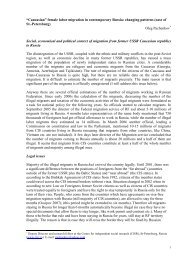THORIUM AS AN ENERGY SOURCE - Opportunities for Norway ...
THORIUM AS AN ENERGY SOURCE - Opportunities for Norway ...
THORIUM AS AN ENERGY SOURCE - Opportunities for Norway ...
You also want an ePaper? Increase the reach of your titles
YUMPU automatically turns print PDFs into web optimized ePapers that Google loves.
Conclusions and Recommendations<br />
thorium has some clear advantages compared with currently operating reactors; much smaller<br />
production of long-lived actinides, minimal probability of a runaway reactor and efficient burning<br />
of minor actinides. The lack of experience in operating such a complex system is a major<br />
drawback. However, the expected development within the on-going EUROTR<strong>AN</strong>S project should<br />
provide in<strong>for</strong>mation about the feasibility of the ADS concept. It is commonly agreed by OECD<br />
countries that energy production with an ADS cannot compete economically with current reactor<br />
technology.<br />
Recommendation 5: The development of an ADS using thorium is out of the scope of the<br />
Norwegian capability alone. Joining the European ef<strong>for</strong>t in that field should be considered.<br />
Norwegian research groups should be encouraged to participate in relevant international projects,<br />
although these are <strong>for</strong> the time being focusing on waste management.<br />
Radioactive Waste from the Front end of the Thorium Fuel Cycle: The dose burden of<br />
waste arising from mining and extraction of thorium is significantly smaller than that from<br />
uranium, due to the short half-life (T1/2) of Rn-220 (T1/2 = 56 sec) compared with the half-life of Rn-<br />
222 (T1/2 = 3.8 days) from U-238 decay chain.<br />
Radioactive Waste from the Back End of the Thorium Fuel Cycle: In contrast to the U-Pu<br />
fuel cycle, plutonium and other transuranics are not produced in a pure Th-232/U-233 cycle. The<br />
radiotoxic inventory of the waste from the Th-U cycle is significantly lower than that of a U-Pu<br />
cycle under the same conditions during the first 1000 years. Already after 100 years, the<br />
radiotoxic inventory of the Th-U cycle is significantly lower than that of natural uranium used in<br />
an open-cycle <strong>for</strong> the same amount of energy.<br />
Recommendation 6: <strong>Norway</strong> should bring its competence with respect to waste management to<br />
an international standard, and collaboration with Sweden and Finland could be beneficial.<br />
Radiation Protection of Man and the Environment: Compared to the uranium cycle the<br />
radiation protection associated with the thorium cycle is in general of less concern. This is<br />
especially so <strong>for</strong> the back end of the ADS. The competence to assess doses and impact to man and<br />
the environment from the thorium cycle in <strong>Norway</strong> is, however, limited. Already today, the high<br />
outdoor gamma doses <strong>for</strong> instance in the Fen Complex call <strong>for</strong> restrictions in use of the area.<br />
Doses to man and the environment from future potential exposures associated with the thorium<br />
fuel cycle will be regulated by the Radiation Protection Act and associated Regulations. However,<br />
authorisation requirements <strong>for</strong> mining and milling thorium are not included in the current<br />
radiation protection regulatory system and revision of the Act will be needed.<br />
Recommendation 7: <strong>Norway</strong> should bring its competence with respect to dose assessment<br />
related to the thorium cycle to an international standard.<br />
Regulation: The Act Concerning Nuclear Energy Activities from 1972 regulates activities<br />
associated with the existing Norwegian research reactors. A conventional thorium-uranium based<br />
nuclear installation will most probably be covered by the current licensing requirement, whereas<br />
a pure thorium-based system such as an Accelerator Driven System (ADS) will not. In such a<br />
case, the Act Concerning Nuclear Energy Activities will require revision.<br />
Non-proliferation: The Th-232/U-233 fuel cycles do not produce plutonium. The proliferation<br />
resistance to U-233 depends on the reactor and reprocessing technologies. In the development of a<br />
reactor technology with its fuel cycle <strong>for</strong> civil purposes, the thorium fuel cycle should have an<br />
advantage concerning the proliferation resistance that can be exploited. However, due to the lack<br />
107

















